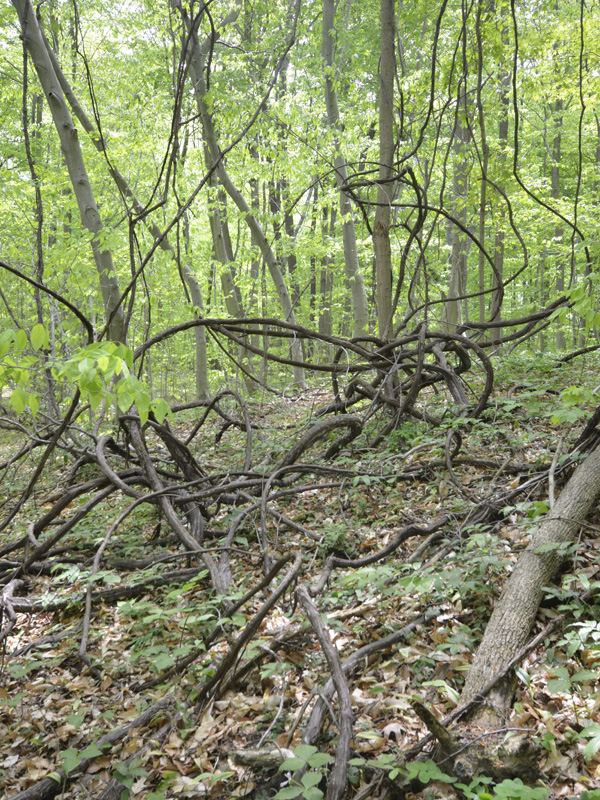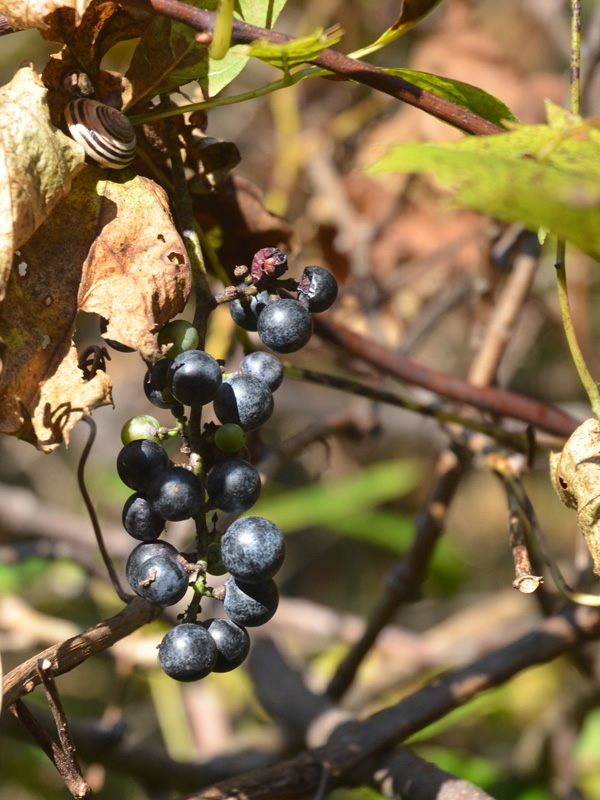| General Description | A climbing multi-stemmed vine. Producing leaves that are large, fine tipped, with coarsely toothed margins with heart shaped bases. From August to October it produces fruit varying in colour from black and purple to amber. It has good autumn colour, creating a colourful swag of green and burgundy. |
| ID Characteristic | A large climbing vine, with tough round branches and chambered piths. Leaves are simple, alternating and lobed, have long-pointed tips, are coarsely toothed along the margin and heart shaped at the base, leaf surface is smooth, and pubescent on the underside. Flowers are found in elongated clusters. |
| Shape | Climbing, multi-stemmed vine. |
| Landscape | Commonly used for rootstock on commercial varietal grapes since it can resist phylloxera and nematodes. Used as hedging and screening, as well as naturalization. |
| Propagation | Seed needs a long cold stratification (0 - 6 °C) but not freezing. Dry seeds need to be soaked for three days, changing the water every day in order to re-moisten the seed. Stratify in moist peat moss in a cold environment for 60 - 120 days followed by germination of about 13 - 16 days. It can also be propagated by cuttings as long as they are made early and before bloom. Cuttings must be 15 cm in length with about 2 - 3 nodes. One of the top leaves must be attached and if it is large, must be cut in half to reduce transpiration. Cuttings must then be placed in a tray or container with moist media. The root zone must be kept at 27 - 29 °C until roots form. The cuttings can then be potted and kept in high humidity environment for a period of one week. When planting cuttings outside, they must be protected from the sun to prevent scalding. |
| Cultivation | Cultivation requires moist soil and adequate sun exposure. When cultivated in containers in the nursery they are ready for ongoing production or transplanting once two leaves have fully formed. |
| Pests | Occaisonnaly affected by leaf galls insects but resistant to phylloxera and nematodes which commonly affect other grape varieties. Xylella a bacterial disease is a serious threat to many horticultures crops due to its virulence and wide range of species it can infect. It can infect more than 560 species with wide ranging symptoms including leaf scorch, yellowing and scorching, wilt, branch and twig dieback and plant death. These symptoms can be identical to other symptoms such as drought and weather stress. Infected plants show symptoms within a few years after planting. |
| Notable Specimens | Morden, Manitoba Research Station in Canada has developed a superior, extra-disease resistant variety of this vine. Joany’s Woods, West Williams, Middlesex County, Ontario, Canada. |
| Habitat | Usually found by streams and riverbanks, along the margins of woods, and in thickets in Canada and the in the United States of America. They are also found in wetlands in the United States of America. |
| Bark/Stem Description | Bark is dark brown in colour and shredding to exfoliating. |
| Flower/Leaf Bud Description | Buds are sometimes referred to as 'eyes,' most commonly found at each node above the leaf and consists of three partially developed shoots. Bud scales are lined with hairs preventing drying out but the bud also has rigid scales protecting it against mechanical injury. Sterile shoots form from the leaf buds and these cannot bear fruit. Shoots from fruit buds have rudimentary leaves and flower clusters. |
| Leaf Description | Leaves are simple and alternating. Leaves have long-pointed tips, coarsely toothed margins, and heart shaped bases. The surface is smooth, but the underside is pubescent. Leaves are 12-20 cm in length, and 8-16 cm in width. Leaves are very dense in the summer. |
| Flower Description | Tiny white flowers in elongated clusters about 10 cm in length. |
| Fruit Description | Fruit vary from purple, black and amber in colour and are about 8-14 mm in diameter and are found from August to October. |
| Colour Description | Bark is dark brown. Leaves are green. Flowers are white. The colour of fruit varies from purple, black and amber. In the autumn leaves create a colourful swag of green and burgundy. |
| Texture Description | Foliage is finely textured. Bark is shredding or exfoliating. |

